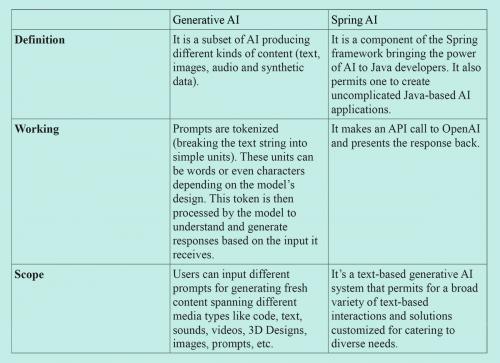How Spring AI is different from Generative AI?
 Spring AI and Generative AI perform the same functions but have stark differences. Let’s take a look at them in the blog below.
Spring AI and Generative AI perform the same functions but have stark differences. Let’s take a look at them in the blog below.Generative AI (GenAI) promises tremendous potential as it is playing a transformative role in diverse industries. The services range from generating creative content to discovering drugs to producing entirely new content as per learned patterns. Moreover, GenAI cannot be looked at in isolation as it’s just a single layer of a complete-stack ecosystem. One needs to address the other layers including infrastructure, data management, user interfaces, and business logic for creating applications that are both meaningful and functional.
Spring AI is a Java application framework designed for AI engineering. It’s a bridge that connects data science and machine learning to Java-based applications. Spring AI helps in seamlessly transitioning to the world of AI. Even though Python is the driving force in AI, there are still several enterprise applications that run on Java via the Spring framework.
Using Spring AI, one need not feel adrift in the AI maze as it offers Spring-based API and abstractions making AI application development very easy. The API framework lends abstractions for streamlining AI application development. The implementation of abstractions in various ways lends developers the power to customize AI functions in an uncomplicated fashion.
A broad overview of Generative AI versus Spring AI
Key Features of Spring AI
1. Output: It is a text-based generative AI system where users input text and relevant text output is generated. This feature permits a broad range of text-based interactions and solutions customized for meeting various needs.
2. Integration: It can be integrated with many models including OpenAI, Azure Open AI, Bedrock (Amazon), Ollama, and Vertex AI (Google). Spring AI utilizes the key capabilities of all these platforms to offer its users cutting-edge AI technology that has a wide range of functions.
3. Output Parser: As a key feature, it does two things. Firstly, it tells the prompt regarding the ideal response format and structure so that outputs are not randomly generated, but presented as per a specified format like JSON and based on the context provided. Secondly, once a prompt is issued and a response received, the output parser organizes the same in a structured format including a Java bean, a list, or possibly a map of values.
4. Document Reader: This is a prominent offering from the Spring AI development team and is especially handy in the context of Retrieval Augmented Generation (RAG).
5. Vector Store Integration: This can be readily integrated with several vector stores including Chroma, Pinecone, Redis, Weavite, etc. It allows one to organize documented data into minor chunks or sub-documents. Before querying an LLM, one can query the vector store to find out what knowledge it has regarding your query.
6. Prompt Templates: Prompt creation implies more than just putting forth a question and expecting a proper response. This method might be ideal for direct inquiries. However, for situations that are much more complicated, it’s necessary to utilize refined templates. The templates are designed in a manner that permits one to insert key details regarding a question or instructions that are being provided to the AI.

Comments